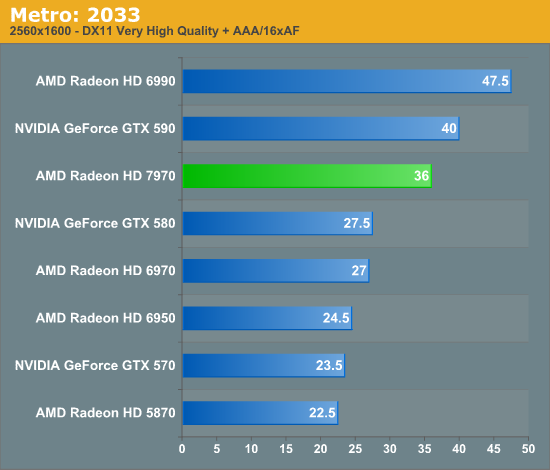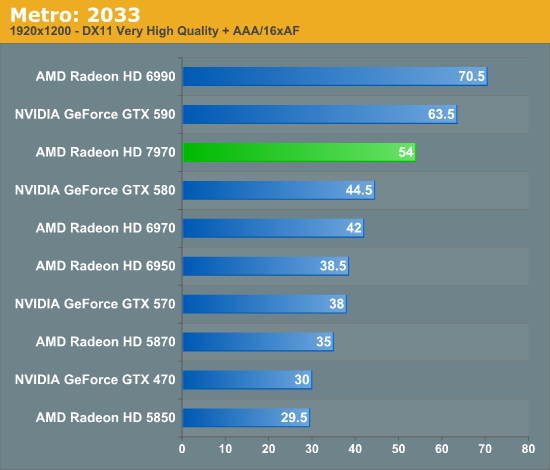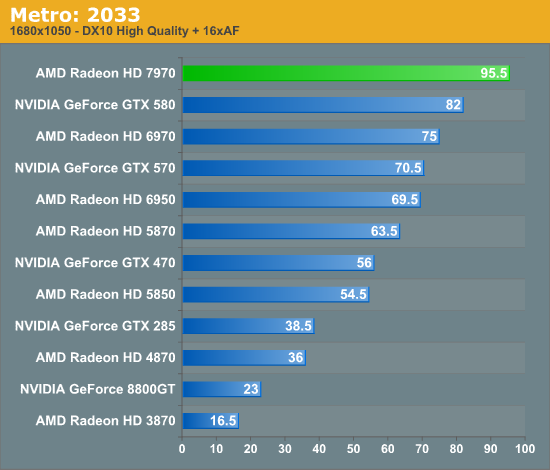AMD Radeon HD 7970 Review: 28nm And Graphics Core Next, Together As One
by Ryan Smith on December 22, 2011 12:00 AM EST- Posted in
- GPUs
- AMD
- Radeon
- ATI
- Radeon HD 7000
Metro: 2033
Paired with Crysis as our second behemoth FPS is Metro: 2033. Metro gives up Crysis’ lush tropics and frozen wastelands for an underground experience, but even underground it can be quite brutal on GPUs, which is why it’s also our new benchmark of choice for looking at power/temperature/noise during a game. If its sequel due this year is anywhere near as GPU intensive then a single GPU may not be enough to run the game with every quality feature turned up.



As often as we concern ourselves with Crysis and 60fps, with Metro it’s a struggle just to break 30fps. The 7970 becomes the first video card that can accomplish this at 2560 though it’s going to need quite a bit more performance to run Metro fluidly from start to end.
Compared to the GTX 580 the 7970’s lead in Metro is similar, but the scaling with resolution is even more pronounced. At 2560 it’s ahead by 30%, while at 1920 this drops to 21%, and finally at 1680 it’s only 16%. Meanwhile compared to the 6970 the response is much flatter; 33% at 2560, 28% at 1920, and 27% at 1680. From this data it’s becoming increasingly evident that the value proposition of the 7970 is going to hinge on not only what you consider its competitors to be, but what resolutions you would use it at.
While we’re on the subject of Metro, this is a good time to bring up the performance of the 5870, the forerunner of the DX11 generation. The performance of the 7970 may only be 20-30% higher than its immediate predecessors, but that’s not to say that performance hasn’t increased a great deal more over the full 2 year period of the 40nm cycle. The 7970 leads the 5870 by 50-60% here and in a number of other games, and while this isn’t as great as some past leaps it’s clear that there’s still plenty of growth in GPU performance occurring.










292 Comments
View All Comments
CrystalBay - Thursday, December 22, 2011 - link
Hi Ryan , All these older GPUs ie (5870 ,gtx570 ,580 ,6950 were rerun on the new hardware testbed ? If so GJ lotsa work there.FragKrag - Thursday, December 22, 2011 - link
The numbers would be worthless if he didn'tAnand Lal Shimpi - Thursday, December 22, 2011 - link
Yep they're all on the new testbed, Ryan had an insane week.Take care,
Anand
Lifted - Thursday, December 22, 2011 - link
How many monitors on the market today are available at this resolution? Instead of saying the 7970 doesn't quite make 60 fps at a resolution maybe 1% of gamers are using, why not test at 1920x1080 which is available to everyone, on the cheap, and is the same resolution we all use on our TV's?I understand the desire (need?) to push these cards, but I think it would be better to give us results the vast majority of us can relate to.
Anand Lal Shimpi - Thursday, December 22, 2011 - link
The difference between 1920 x 1200 vs 1920 x 1080 isn't all that big (2304000 pixels vs. 2073600 pixels, about an 11% increase). You should be able to conclude 19x10 performance from looking at the 19x12 numbers for the most part.I don't believe 19x12 is pushing these cards significantly more than 19x10 would, the resolution is simply a remnant of many PC displays originally preferring it over 19x10.
Take care,
Anand
piroroadkill - Thursday, December 22, 2011 - link
Dell U2410, which I have :3and Dell U2412M
piroroadkill - Thursday, December 22, 2011 - link
Oh, and my laptop is 1920x1200 too, Dell Precision M4400.My old laptop is 1920x1200 too, Dell Latitude D800..
johnpombrio - Wednesday, December 28, 2011 - link
Heh, I too have 3 Dell U2410 and one Dell 2710. I REALLY want a Dell 30" now. My GTX 580 seems to be able to handle any of these monitors tho Crysis High-Def does make my 580 whine on my 27 inch screen!mczak - Thursday, December 22, 2011 - link
The text for that test is not really meaningful. Efficiency of ROPs has almost nothing to do at all with this test, this is (and has always been) a pure memory bandwidth test (with very few exceptions such as the ill-designed HD5830 which somehow couldn't use all its theoretical bandwidth).If you look at the numbers, you can see that very well actually, you can pretty much calculate the result if you know the memory bandwidth :-). 50% more memory bandwidth than HD6970? Yep, almost exactly 50% more performance in this test just as expected.
Ryan Smith - Thursday, December 22, 2011 - link
That's actually not a bad thing in this case. AMD didn't go beyond 32 ROPs because they didn't need to - what they needed was more bandwidth to feed the ROPs they already had.